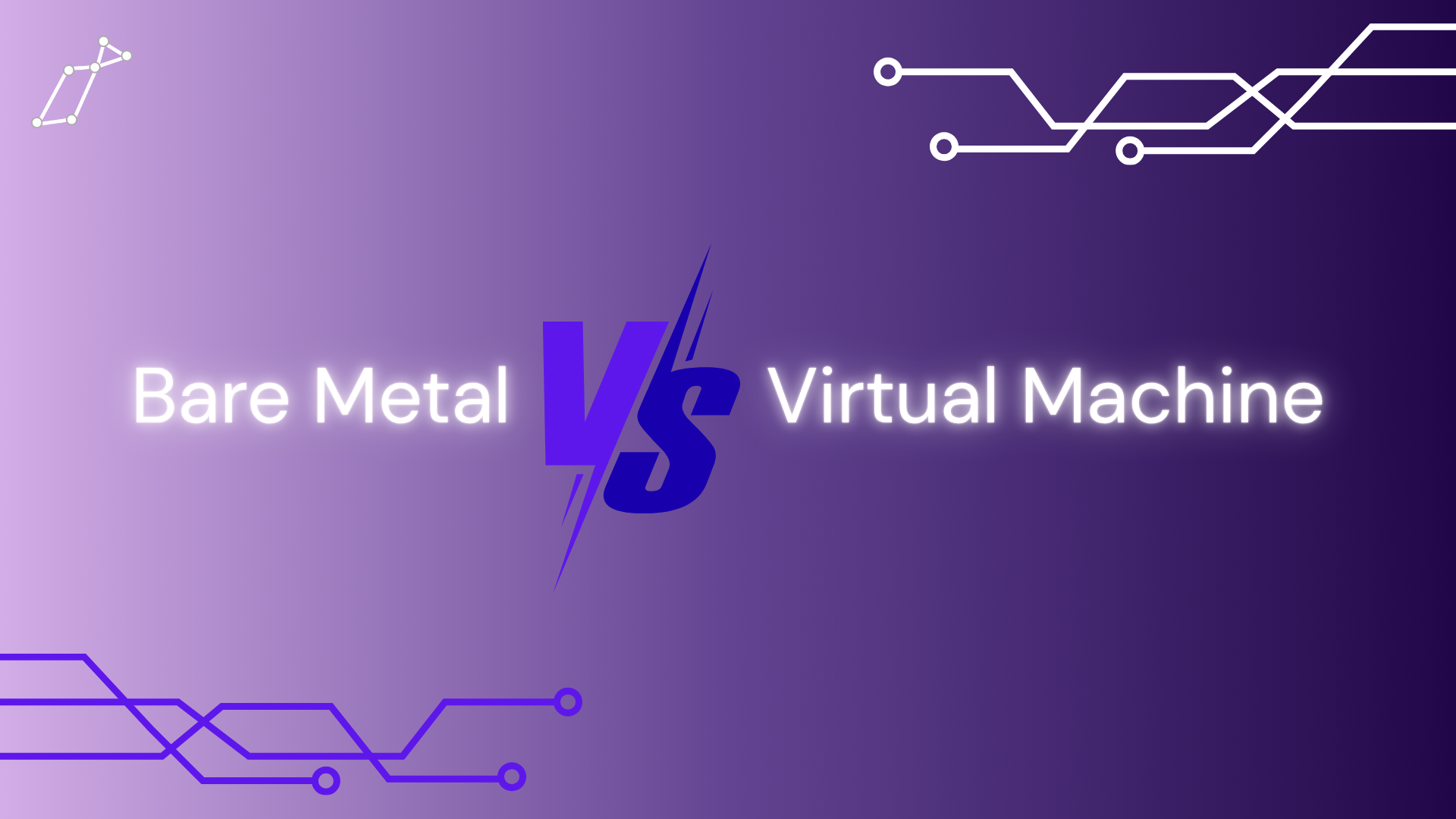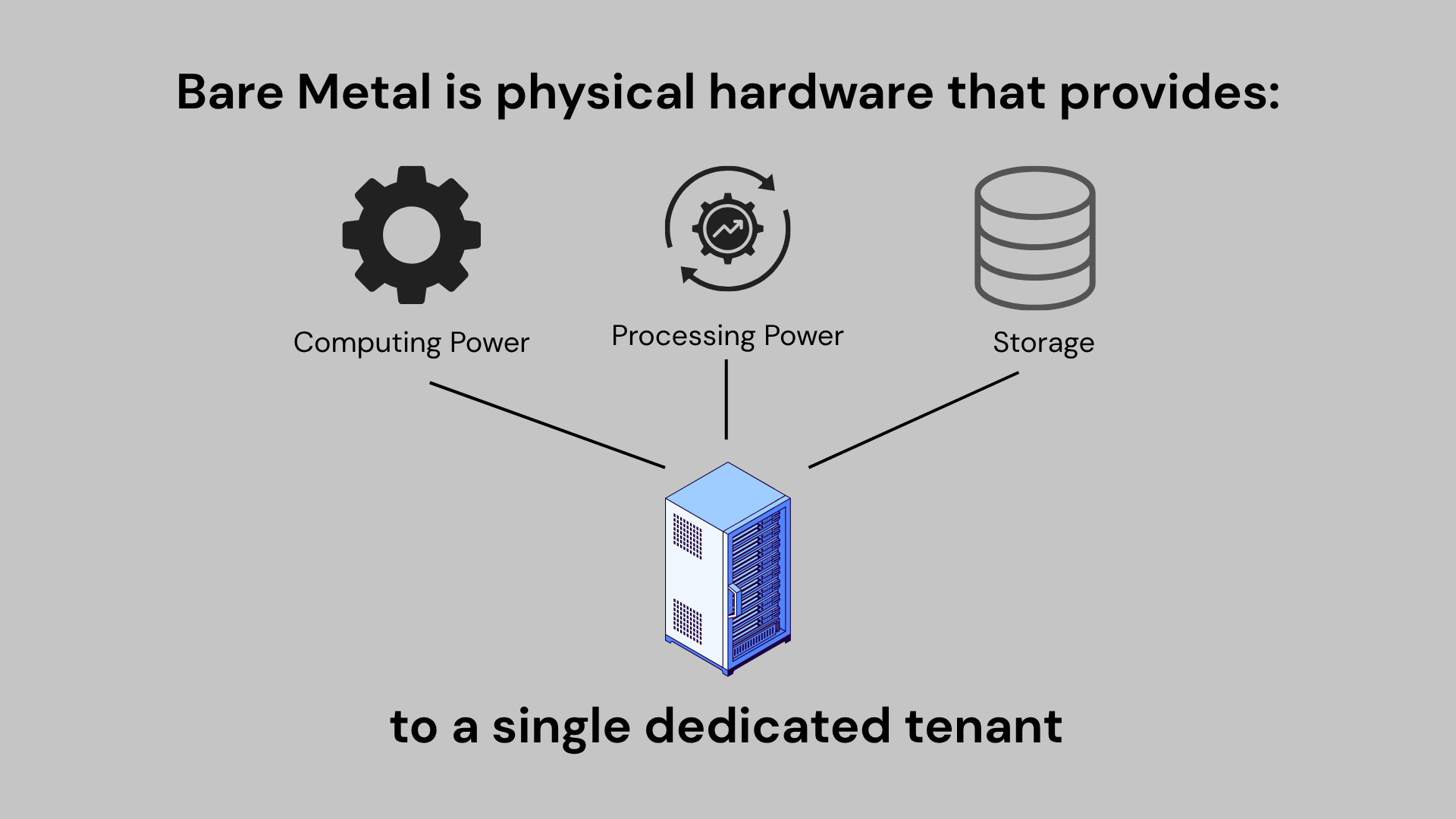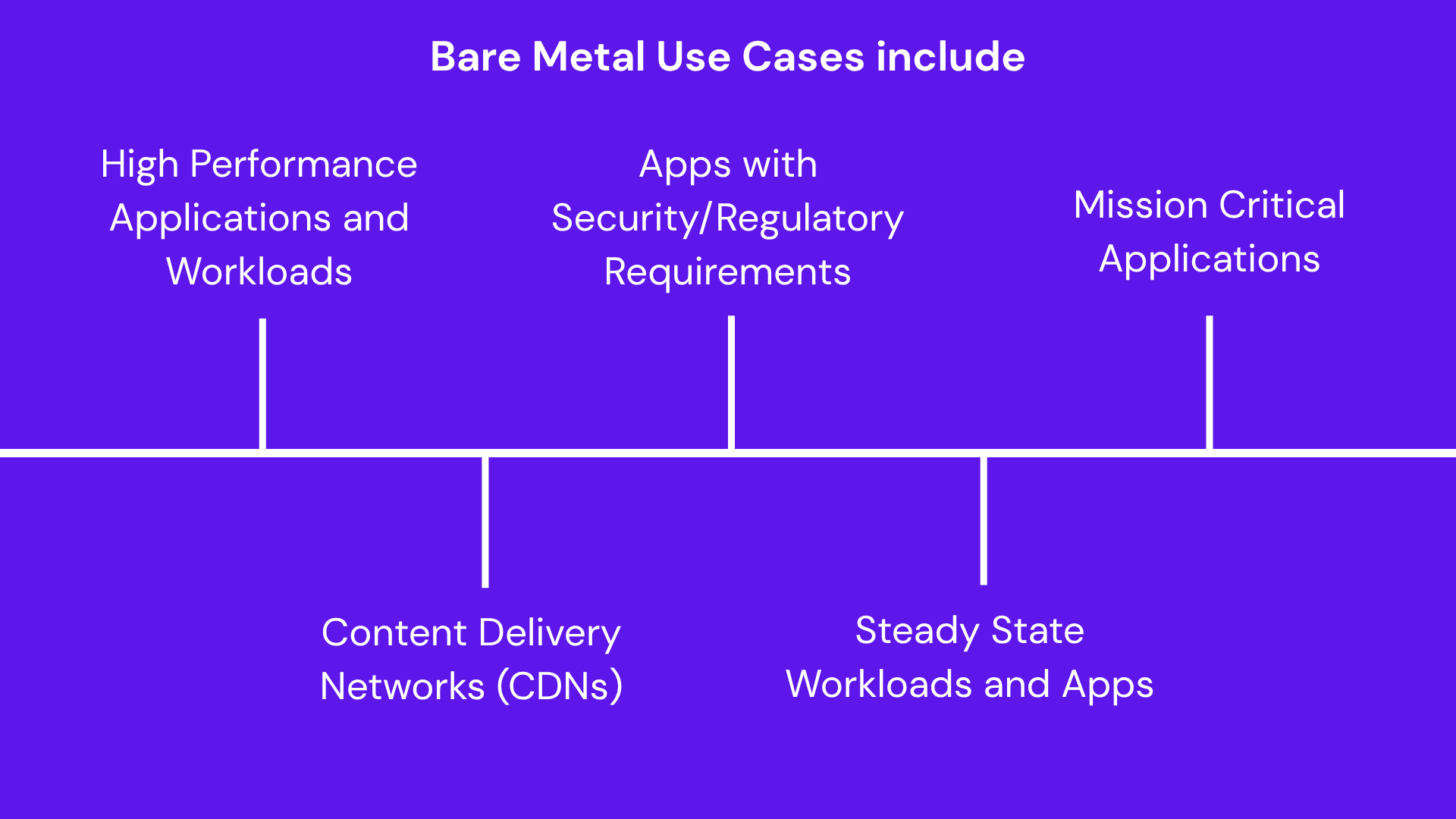Bare Metal vs VM: Distinctions, Benefits, and How to Choose the Right One



Why Bare Metal vs VM?
Choosing where and how to host your application requires deep knowledge of technical requirements and planning ahead, with two of the most common hosting solutions being bare metal and virtual machines (VM). The bare metal vs VM debate pits two technological giants against each other.
On one end is bare metal, mobilizing physical machinery dedicated to only a single tenant and through a cloud service. On the other is a virtual machine, offering a virtualization of a physical computer that runs software through multiple layers of software abstraction. Choosing the right hosting option will largely depend on the nature of an application, including uptime requirements, resource consumption and constraints, team budget, and so on.
But what is bare metal server vs virtual machine? And what uses do each hosting approach have?
What is Bare Metal?
As mentioned above, bare metal/bare metal server is a physical server that is dedicated to one tenant. Typically rented through cloud service providers, bare metal servers are fully customizable, often built solely to support a specific application. Despite the ‘bare’ in bare metal referring to machinery stripped of additional software layers, bare metal is anything but barren.
Offering resources like computing power, processing power, storage, and more, bare metal is an extremely powerful hosting option that offers unparalleled benefits, though at a cost.

Benefits of Bare Metal
Bare metal is unique because of its physicality, allowing users to manually configure and customize machine loadouts on a granular level. The ‘bare’ aspect of bare metal is also a key point of the technology, with such strong benefits of bare metal usage including:
- Granular hardware and software customization
- Reduced latency by removing software abstraction layers
- Flexible cost savings through pay-as-you-go model and hardware/software customizing
- Streamlined management in a single server
- Improved performance through hardware optimization
- Enhanced security through full isolation
Bare metal machinery prioritizes customizability and performance above all else, giving users granular control when assembling both hardware and software stacks. This provides a truly unique experience, with no bare metal deployment looking the same as they are specified designed for a singular application.
Disadvantages of Bare Metal
Despite the benefits offered by bare metal servers, it is undeniable that there are certain disadvantages that may outweigh the pros of bare metal. From rising costs to scalability issues to even security, bare metal disadvantages should be taken into consideration before hosting. Such disadvantages include:
- Rising costs due to specialized hardware and software, costs may go up with usage as well
- Scaling requires additional hardware and an identical server to conduct
- Configuration complexity may stop users from taking full advantage of their hardware
- Increased security risks due to physical security
For bare metal users, it is important to gauge what usage would look like down the line:
- Does your application require immense computing and storage power?
- Can you foresee your application requiring immense scale?
- Will bare metal and a physical presence be viable down the line?
Use Cases for Bare Metal Servers
Bare metal servers are powerful, offering customizability and performance at the expense of cost and scaling constraints. For these reasons exactly, bare metal hosting is the best for:
High Performance Applications and Workloads
Applications that need constant processing power, uptime, and speed require the reliability of bare metal processing. This performance requirement may also extend to requiring vast amounts of data transfers both in and out. Applications that would fit under these criteria include big data applications, high performance databases, scientific research, and finance-based applications.
Content Delivery Networks (CDNs)
Bare metal servers offer consistent and reliable performance while ensuring low latency with stripped software layers. Direct access to hardware layers for customization allows CDN teams to optimize content delivery and flow.
For teams looking for worldwide CDN operations accessible through bare metal servers and data center partners, we will be offering CDN options utilizing Lyrid’s strong global data center network- stay tuned for more information!
Applications with Security and Regulatory Requirements
The physical presence of bare metal aids in the globalization of companies by assisting in meeting global compliance through global data center presence.
Steady State Workloads and Applications
Workloads that operate consistently for long periods of time without immensely modifying resource requirements can benefit greatly from the reliability and performance of bare metal servers. The physicality of a server may also increase the fault tolerance of these workloads, offering physical security and uptime in a cloud-dominated world
Applications with a similar set of characteristics can benefit from bare metal too, including supply chain management systems, customer relationship management systems, and enterprise resource planning applications.
Mission Critical Applications
Due to the reliability of bare metal systems, especially in times of stress, applications that depend on high uptime and are mission critical in their industry can benefit the most from bare metal servers. Systems and applications such as healthcare systems, point of service systems, and traffic control systems stand out.
Bare metal is a jack of all trades, offering competence in situations that are variable, but also consistent and predictable. For applications requiring high uptime and availability, bare metal is a must.

What is a Virtual Machine?
While bare metal represents a physical presence in the hosting space, virtual machines are well.... virtual. As the name suggests, virtual machines (VMs) are emulations of a physical computer achievable through a process called virtualization. Don’t get it wrong, though: virtual machines run ON TOP of physical servers, just creating multiple computers in one instance.
VMs operate through layers of software abstraction, allowing multiple VMs to operate on a single physical computer. What makes VMs so unique is that each one has their own operating system, with multiple tenants sharing these VMs.
VMs are typically offered and expected in a cloud environment, allowing cloud services providers to maximize resource provisioning and utilization across VM users.

Benefits of Virtual Machine
Compared to bare metal being limited by a physical state, virtual machines offer unique advantages by primarily being offered online. Such benefits of using VMs include:
- Flexible pricing due to cloud offerings and widespread availability
- Increased flexibility and scalability
- Streamlined provisioning and management
- Support of legacy applications and reduced migration downtime
- Seamless transferring to different bare metal host via virtualization
- Enhanced configuration options
Virtual machines offer strong benefits pertaining to scalability and flexibility, not only in the application itself, but also in the environment that it is hosted on. VMs are a great option for users that need speed and adaptability, with applications on VMs operating under different levels of workload stress.
Disadvantages of Virtual Machines
Despite the flexibility and ease of scaling that virtual machines have to offer, some issues arise when considering the software abstraction layer and multiple tenants. Disadvantages of virtual machines include:
- Increased security threats as a result of sharing one physical server with multiple tenants
- Latency issues caused by layers of software- one problem affects all the layers
- Nosy neighbor effect- slowdowns by increased resource consumption from multiple tenants
- Potentially slowed resource utilization due to shared resources
- Maintenance requires skilled professionals to conduct
Virtual machines, though offering flexibility and scalability, may falter due to reliance on cloud service providers. The presence of multiple tenants within a single physical server may also threaten VM operations, slowing down resource utilization and bandwidth in times of high traffic.
Virtual Machine Use Cases
Virtual machines have the ability to operate across multiple different environments, removing the limitations of physicality that bare metal servers have. Strong virtual machine use cases include:
Software Development and Testing
VMs can access and work across various environments while creating wholly isolated environments. Dedicated environments created by VMs are perfect for testing because of the isolation aspect, allowing testing teams and software developers to tinker without worrying about affecting the production environment.
Any application that requires multiple iterations can make the most of VMs.
Legacy System Operations
Legacy systems can be hard to migrate out of or modernize, eventually leaving an application trapped if unable to shift to a new environment. VMs allow a virtual version of an old software to be created, consequently increasing security from threats that legacy systems are susceptible to.
Certain systems such as traffic control, banking systems, and background checks systems that use legacy systems can benefit from the modernization and simplicity that VMs offer.
Disaster Recovery
Virtual machines are lightweight, allowing for quick replication and provisioning. In the scenario of server outages or disaster, VMs can shift between different environments and even mobilize replicants of themselves to continue operations seamlessly.
Cloud Computing Uses
Virtual machines are the go-to option for cloud computing software just because of their flexibility alone, allowing multi cloud or hybrid cloud applications to operate without skipping a beat.

Bare Metal vs Virtual Machine: How to Choose?
The bare metal vs virtual machine debate is one that doesn’t necessarily pit the options against each other, but one that depends strictly on your business and application.
On one end is bare metal, the physical server dedicated to hosting a single application. Bare metal is best known for its reliability and performance, offering strong value based on the user’s customization. Pitfalls of bare metal include costs and scaling issues. Despite this, systems that need high uptime such as healthcare systems and traffic control systems rely on bare metal for operations.
On the other hand are virtual machines, virtual representations of computer systems built on top of physical machinery. VMs contain different internal layers that contribute to their flexibility and scalability, allowing for adaptability and seamless cross-environment operations. Disadvantages of virtual machines, however, include operational slowdowns due to resource pigeonholes, as well as latency issues caused by necessary software layers. Despite these pitfalls, VMs are perfect for a variety of different applications and even legacy systems.
When deciding between between a bare metal server vs virtual server, you should consider the following questions:
- What degree of scalability does your application need?
- Does your system experience high traffic on a normal basis? What about during holidays?
- What is your resource budget at the moment?
- Does your application need constant uptime, and how will disaster affect it?
These questions are a good start before deciding which hosting method will be best for your
application, however, do not limit yourself to answering only these.
Approaching Bare Metal with Lyrid
Whether your application requires constant uptime and performance, or the flexibility to grow and shift environments, bare metal and virtual machines are competent hosting options that have proven to be successful time and time again. However, another hosting option combines the power and reliability and bare metal with the flexibility of virtual machines: Kubernetes bare metal.
At Lyrid, we’re bare metal enthusiasts. Our data center network and partnerships bring global bare metal resources closer to users than ever before (and more cost-effectively than some of the hyperscalers out there). Users can enjoy powerful bare metal hardware with the Lyrid PaaS on top of it, offering Kubernetes capabilities and other managed services. Bare metal Kubernetes is a new form of hosting that offers Kubernetes on top of bare metal machinery. And we’re excited that our version can compete with some of the big dogs in the space.
Powerful machinery, streamlined software, and global availability- all at a cost that makes everyone happy. That’s what we’re achieving with bare metal Kubernetes. If you’re interested in trying it out for yourself, book a demo with one of our product specialists!











